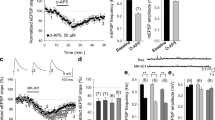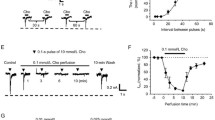Abstract
The purpose of this paper was to examine the function of N-methyl-D-aspartate (NMDA) glutamate receptor in cortical neurons on amino acid neurotransmitters release as well as the fraction of neurons implicated in the response of this receptor. Local stimulation of these cells at different concentrations of NMDA, agonist of this ionotropic glutamate receptor, produced a dose dependent release of aspartate, glutamate, glycine and GABA. These effects were blocked by DAP5, an antagonist of the NMDA receptor. The amino acid Ca2+ dependent release mediated by the NMDA receptor, is induced by the opening of voltage-dependent Ca2+ channels that this receptor promotes. Ca++ movements were explored in single cells loaded with fura-2. When single cells were stimulated with 100 μM NMDA, the calcium recording performed showed that 82% of the cells responded to this agonist increasing the intracellular calcium concentration, although the amplitude of these increments was variable. The results suggest that NMDA-elicited neurotransmitter release from cortical neurons involves Ca2+-dependent and Ca2+-independent components, as well as neuron depolarisation, and different VDCC subtypes of N, P/Q or L depending of the amino acid neurotransmitter release elicited by this receptor.







Similar content being viewed by others
References
De Belleroche J, Recordati A, Rose FC (1984) Elevated levels of amino acids in the CSF of moto neuron disease patients. Neurochem Pathol 2:1–6
Choi DW (1988) Glutamate neurotoxicity and diseases of the nervous system. Neuron 1:623–634
Lipton SA, Kater SB (1989) Neurotransmitter regulation of neuronal outgrowth, plasticity and survival. Trends Neurosci 12:265–270
Meldrum B, Garthwaite J (1990) Excitatory amino acid neurotoxicity and neurodegenerative disease. Trend Pharmacol Sci 11:379–387
Nei K, Matsuyama S, Shuntoh H et al (1996) NMDA receptor activation induces glutamate release through nitric oxide synthesis in guinea pig dentate gyrus. Brain Res 728:105–110
Fontana G, De Bernardi R, Ferro F et al (1996) Characterization of the glutamate receptors mediating release of somatostatin from cultured hippocampal neurons. J Neurochem 66:161–168
Cheramy A, Godeheu G, L`Hirondel M et al (1996) Cooperative contributions of cholinergic and NMDA receptors in the presynaptic control of dopamine release from synaptosomes of the rat striatum. J Pharmacol Exp Ther 276:616–625
Garcia Y, Ibarra C, Jaffe EH (1995) NMDA and non-NMDA receptor-mediated release of [3H] GABA from granule cell dendrites of rat olfactory bulb. J Neurochem 64:662–669
Janaky R, Varga V, Oja SS et al (1994) Release of [3H] GABA evoked by glutamate agonists from hippocampal slices: effect of dithiothreitol and glutathione. Neurochem Int 24:575–582
Young AM, Bradford HF (1993) N-methyl-D-aspartate releases gamma-aminobutyric acid from rat striatum in vivo: a microdialysis study using a novel preloading method. J Neurochem 60:487–492
Puttfarcken PS, Handen JS, Montgomery DT et al (1993) N-Acethyl-aspartylglutamate modulation of N-methyl-D-aspartate-stimulated [3H]norepinephrine release from rat hippocampal slices. J Pharmacol Exp Ther 266:796–803
Jedema HP, Moghddam B (1996) Characterization of excitatory amino acid modulation of dopamine release in the prefrontal cortex of conscious rats. J Neurochem 66:1448–1453
Toth E, Sershen H, Hashim A et al (1992) Effect of nicotine on extracellular levels of neurotransmitters assessed by microdialysis in various brain regions: role of glutamic acid. Neurochem Res 17:265–271
Kendrick KM, Guevara-Guzman R, De la Riva C et al (1996) NMDA and kainate-evoked release of nitric oxide and classical transmitters in the rat striatum: in vivo evidence that nitric oxide may play a neuroprotective role. Eur J Neurosci 8:2619–2634
Smolders I, Sarre S, Vanhaesendonck C et al (1996) Extracellular striatal dopamine and glutamate after decortication and kainite receptor stimulation, as measured by microdialysis. J Neurochem 66:2373–2380
Tanaka J, Miyakubo H, Kawakami A et al (2006) Involvement of NMDA receptor mechanisms in the modulation of serotonin release in the lateral parabranchial nucleus in the rat. Brain Res Bull 71:311–315
Paes PCA, De Magalhaes L, Camillo MAP et al (2004) Ionotropic glutamate receptors regulating labeled acetylcholine release from rat striatal tissue in vitro: possible involvement of receptor modulation in magnesium sensitivity. Neurosc Res 49:289–295
Kater SB, Mattson MP, Cohan C et al (1988) Calcium regulation of the neural growth cone. Trends Neurosci 11:315–321
McDonald JW, Johnston MV (1990) Physiological and pathophysiological roles of excitatory amino acids during the central nervous system development. Brain Res 15:41–70
Stout AK, Woodward JJ (1994) Differential effects of nitric oxide gas and nitric oxide donors on depolarization-induced release of [3H]norepinephrine from rat hippocampal slices. Neuropharmacology 33:1367–1374
Jones NM, Loiacono RE, Beart PM (1995) Roles for nitric oxide as intra- and interneuronal messenger at NMDA release-regulating receptors: evidence from studies of the NMDA-evoked release of [3H]noradrenaline and D-[3H]aspartate from rat hippocampal slices. J Neurochem 64:2057–2063
Moller M, Jones NM, Beart PM (1995) Complex involvement of nitric oxide and cGMP at N-methyl-D-aspartic acid receptors regulating gamma-[3H]aminobutyric acid release from striatal slices. Neurosci Lett 190:195–198
Dumuis A, Sebben M, Haynes L et al (1988) NMDA receptors activate the arachidonic acid cascade system in striatal neurons. Nature 336:68–70
Barbour B, Szatkowski M, Ingledew N et al (1989) Arachidonic acid induces a prolonged inhibition of glutamate uptake into glial cells. Nature 342:918–920
Bouchard R, Pattarini R, Geiger JD (2003) Presence and functional significance of presynaptic ryanodine receptors. Prog Neurobiol 69:391–418
Collin T, Marty A, Llano I (2006) Presynpatic Ca2+ stores and synaptic transmission. Curr Opin Neurobiol 15:275–281
Bardo S, Cavazzini MG, Emptage N (2006) The role of endoplasmic reticulum Ca2+-store in the plasticity of central neurons. Trends Pharmacol Sci 27:78–84
Rusakov DA (2006) Ca2+-dependent mechanisms of presynaptic control at central synapses. Neuroscientist 12:317–326
Christie JM, Jahr CE (2008) Dendritic NMDA receptors activate axonal calcium channels. Neuron 60:298–307
Segal M (1983) Rat hippocampal neurons in culture: responses to electrical and chemical stimuli. J Neurophysiol 50:1249–1264
Marquez FJ, Quesada AR, Sanchez-Jimenez F et al (1986) Determination of 27 dansyl amino acid derivatives in biological fluids by reversed-phase high-performance liquid chromatography. J Chromatogr 380:275–283
Bradford M (1976) A rapid sensitive method for the quantitation of microgram quantities of protein utilizing the principle of protein-dye binding. Anal Biochem 72:248–253
Tsien RY, Hladky SB (1978) A quantitative resolution of spectra of a membrane potential indicator, diS-C3-(5), bound to cell components and to red blood cells. J Membr Biol 38:73–97
Waggoner AS (1979) Dye indicators of membrane potential. Annu Rev Biophys Bioeng 8:47–68
Grynkiewicz G, Poenie M, Tsien RY (1985) A new generation of Ca2+ indicators with greatly improved fluorescence properties. J Biol Chem 260:3440–3450
Szatkowski M, Barbour B, Attwell D (1990) Non-vesicular release of glutamate from glial cells by reversed electrogenic uptake. Nature 348:443–446
Sundström E, Mo L-L, Seiger A (1995) In vivo studies on NMDA-evoked release of amino acids in the rat spinal cord. Neurochem Int 2:185–193
Brosius DC, Hackett JT, Tuttle JB (1992) Ca2+-independent and Ca2+-dependent stimulation of quantal neurosecretion in avian ciliary ganglion neurons. J Neurophysiol 68:1229–1234
Yoshimura H, Sugai T, Onoda N et al (2001) Synchronized population oscillation of excitatory synaptic potentials dependent of calcium-induced calcium release in rat neocortex layer II/III neurons. Brain Res 915:94–100
Gao WJ, Goldman-Rakic PS (2006) NMDA receptor-mediated epiteliform persistent activity requires calcium release from intracellular stores in prefrontal neurons. Exp Neurol 197:495–504
Fossier P, Baux G, Trudeau LE et al (1992) Involvement of Ca2+-uptake by a reticulum-like store in the control of transmitter release. Neuroscience 50:427–434
Courtney MJ, Nicholls DG (1992) Interactions between phospholipase C-coupled and N-methyl-D-aspartate receptors in cultured cerebellar granule cells: protein kinase C mediated inhibition of N-methyl-D-aspartate responses. J Neurochem 59:983–992
Simpson PB, Challiss RA, Nahorski SR (1995) Neuronal Ca2+ stores: activation and function. Trends Neurosci 18:299–306
McMahon HT, Nicholls DG (1990) Glutamine and aspartate loading of synaptosomes: a reevaluation of effects on calcium-dependent excitatory amino acid release. J Neurochem 54:373–380
Zhou M, Peterson CL, Lu YB et al (1995) Release of glutamate and aspartate from CA1 synaptosomes: selective modulation of aspartate release by ionotropic glutamate receptor ligands. J Neurochem 64:1556–1566
Nicholls D, Attwell D (1990) The release and uptake of excitatory amino acids. Trends Pharmacol Sci 11:462–468
Ragozzino D, Eusebi F (1993) Inhibition of GABA and glycine responses by glutamate in rat hippocampal neurons. Brain Res 628:115–120
Shahi K, Baudry M (1993) Glycine-induced changes in synaptic efficacy in hippocampal slices involve changes in AMPA receptors. Brain Res 627:261–266
Danysz W, Parsons CG (1998) Glycine and N-methyl-D-aspartate receptors: physiological significance and possible therapeutic applications. Pharmacol Rev 50:597–664
Acknowledgments
This study was supported by the grants SAF2006-05563 from Ministry of Education (MEC, Spain) and CCG07-UCM/SAL-3024 (Complutense University/Madrid Community). The authors thank to Mikel Erdocia Arce for his help in improving the manuscript.
Author information
Authors and Affiliations
Corresponding author
Rights and permissions
About this article
Cite this article
López, E., Hernandez, J., Arce, C. et al. Involvement of NMDA Receptor in the Modulation of Excitatory and Inhibitory Amino Acid Neurotransmitters Release in Cortical Neurons. Neurochem Res 35, 1478–1486 (2010). https://doi.org/10.1007/s11064-010-0209-0
Accepted:
Published:
Issue Date:
DOI: https://doi.org/10.1007/s11064-010-0209-0




